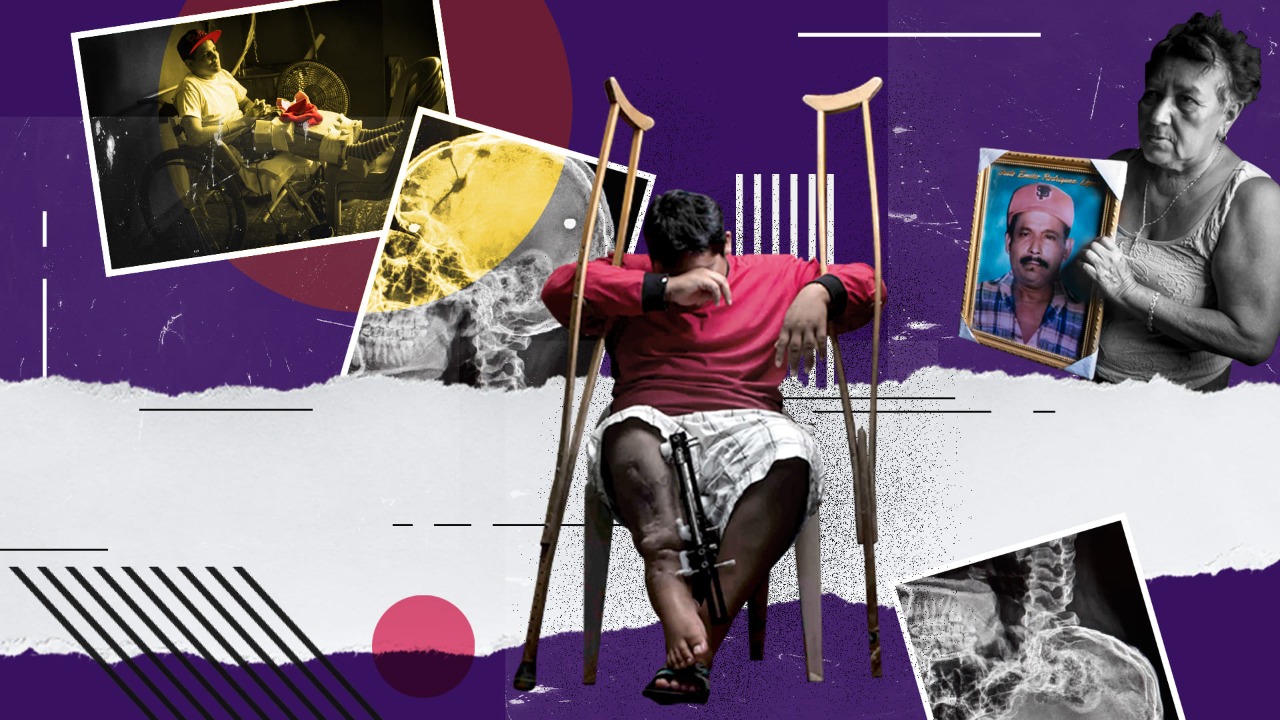The New Generation of People Crippled by Repression in Nicaragua
Paraplegia, eye trauma, limb amputation, punctured vital organs and even individuals in vegetative states. State repression in Nicaragua has resulted in over 2,000 disabled people. This feature portrays the conditions under which victims of the 2018 protests live today, echoing the tragedy of the 80s.
By Hans Lawrence Ramírez
In the municipality of Nueva Guinea, in Nicaragua’s southern Caribbean Coast, everyone wished Holver Zelaya would bat for their team when they got together for a baseball game. Holver, 36, is a well-built man: he is almost 6 feet tall, has broad shoulders and sun-kissed skin. He is a farmer who brags about his batting skills.
He used to spend his days horseback riding and working his land, at the end of the day, he went home to his wife and his two daughters. But that is all in the past. For four years now, Holver hasn’t been horseback riding, he can’t play baseball or work anymore. A shotgun pellet fired by a member of the paramilitary at the command of the Nicaraguan government broke his spine.
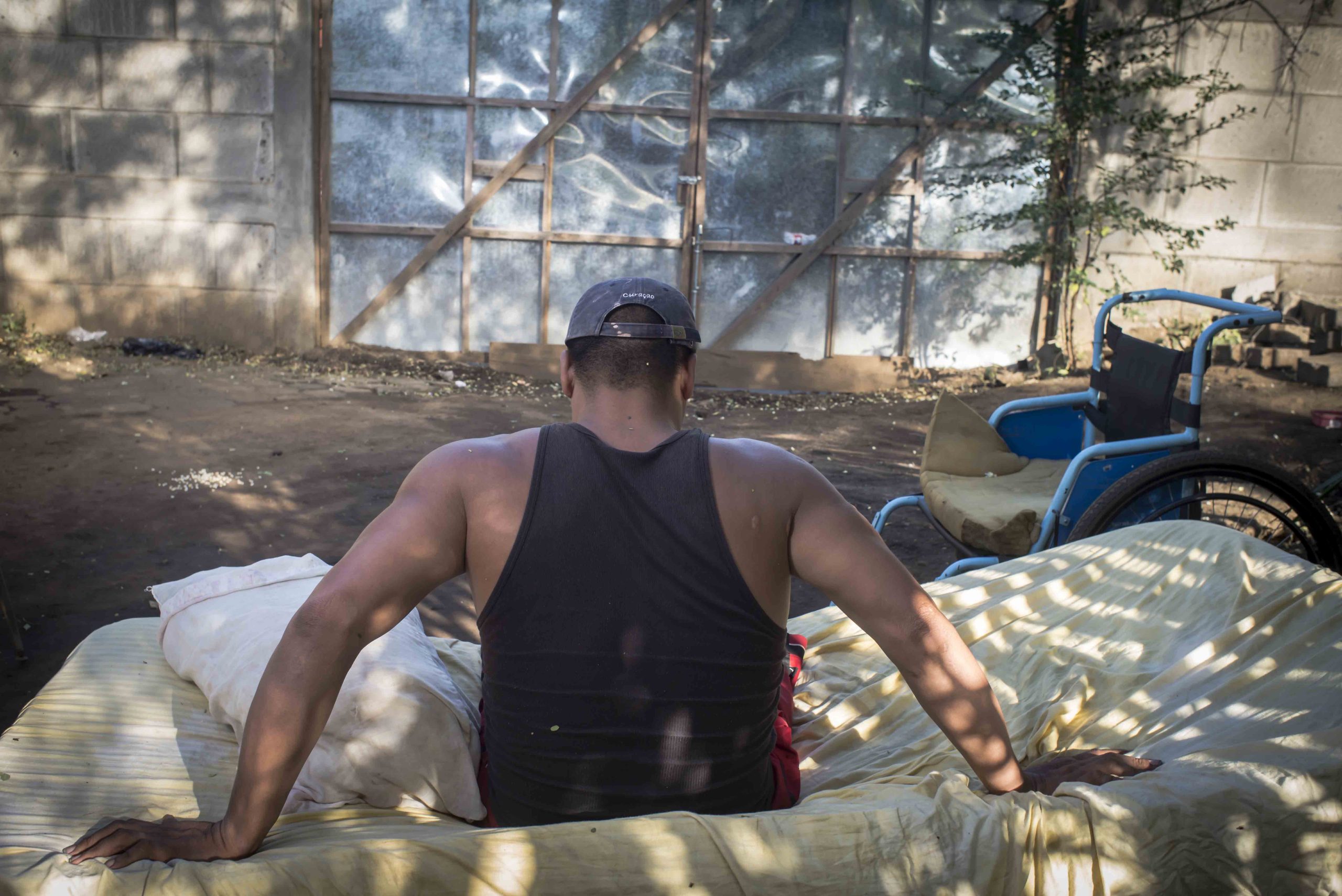
On April 18th, 2018, when protests against the Sandinista regime broke out in response to a reform of the Nicaraguan Institute of Social Security (Instituto Nicaraguense de Seguridad Social, INSS). The State replied with repression. On April 19th, the first casualties of gunfire were reported, according to the IACHR (Inter-American Commission on Human Rights). From that day on, the protests spread like wildfire throughout the country.
These first casualties put the reform of the INSS on the backburner for many Nicaraguans, and protesters started demanding the resignation of Daniel Ortega, his wife and Vice President, Rosario Murillo, and the entire cabinet. The country faced five months of demonstrations that were strongly repressed by agents of the State and armed civilians at the command of Sandinismo; deaths were copious. At that point, the Police had to forbid all types of protests. To date, the political repression in Nicaragua has left a balance of 355 deaths, as per data of the IACHR.
Holver was one of hundreds of Nicaraguans who joined the protests from the very beginning; he helped block one of the country’s main roads alongside other farmers of the area. These blockades were called “tranques” and were intended to prevent civil armed pro-government groups and Police caravans from traveling to the towns to repress the population.
June 12th, 2018, was the last day that Holver was able to walk. The farmer explains that he left the blockade of San Pedro de Lovago, where he was stationed along with more or less twenty people. They had been warned about “Operacion Limpieza”, an operation conducted by paramilitaries which put them at risk of murder. The operation attempted to lift the opposition’s blockades throughout the country by force.
Holver and the others were headed back to their communities walking through trails when a group of armed paramilitaries suddenly came out of the bushes and the undergrowth. “We were shot right there. We were ambushed”, he adds.
Only three people survived, he recalls. Holver lost consciousness due to the attack. He doesn’t remember for how long, but he woke up several days later somewhere in Managua, the capital, and he couldn’t move his legs. He was taken to a private hospital by strangers, there, doctors removed a shotgun pellet that left him paraplegic for life.
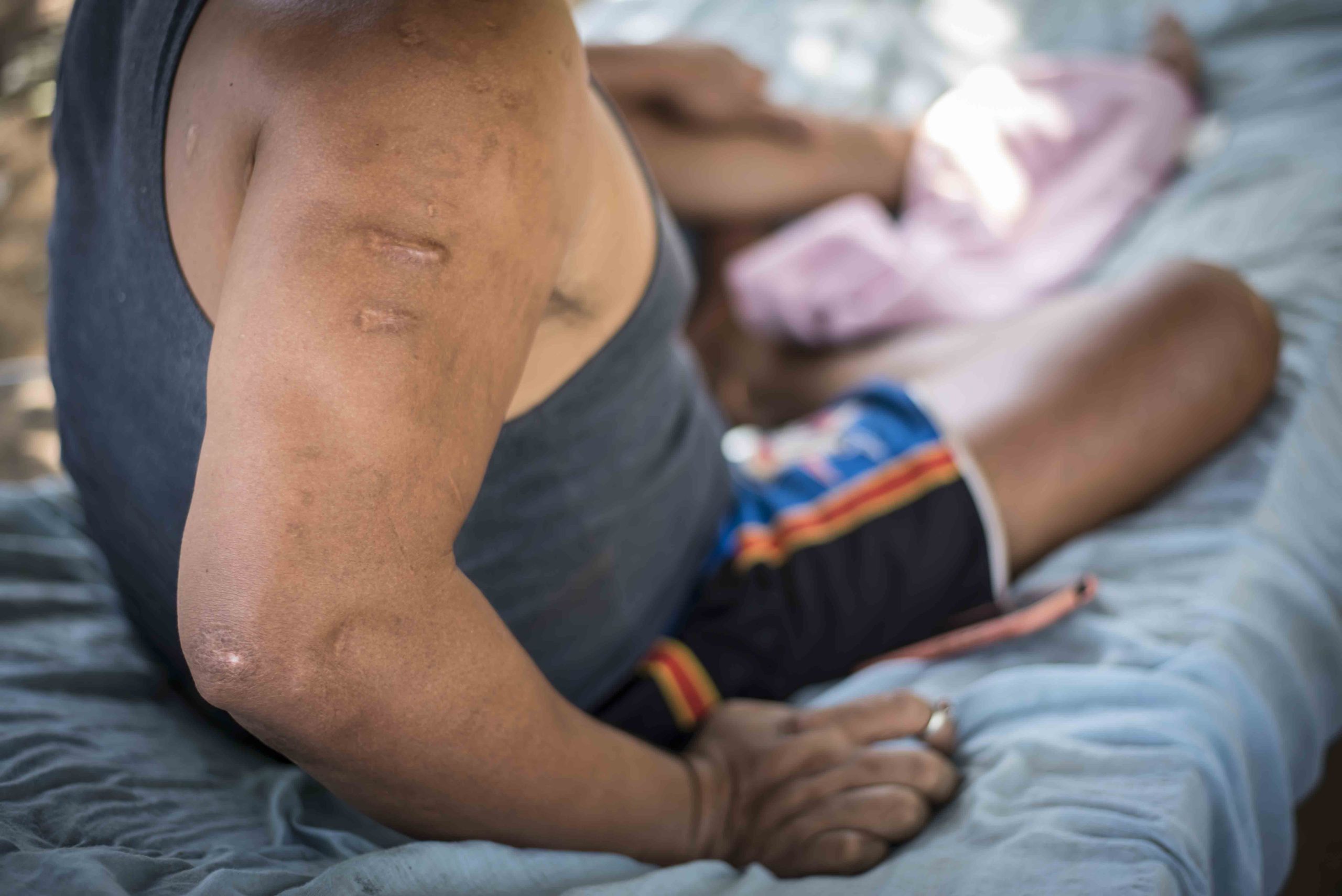
Similarly to Holver, Isaac Ramirez joined the protests in 2018. Back then, he was enrolled in the first year of gastronomy at UPOLI (Universidad Politecnica de Nicaragua) and he used to practice martial arts in a gym near his house in Managua. He was into baseball as well. But that all came to an end for him on June 23rd, when he was shot in the right leg.
It was night time. Isaac was in one of the barricades in the backstreet of UPOLI, which was under the control of students protesting against the government of Nicaragua. There was a power shortage in the area at around 10 pm, and the Police and armed paramilitaries opened fire on the demonstrators, the young man claims.
Isaac, as well as the others, tried to offset the repression with slingshots and marbles. When they realized that there was nothing they could do against the Police and paramilitary bullets, they decided to leave the barricade and take shelter in the facilities of the UPOLI.
He was running in the dark and he unexpectedly fell. “My foot went numb,” he says. He grabbed the right leg and noticed it was damp; while he discerned it was blood, a paramilitary butt-stroked him and left him unconscious.
Now he is 22. He couldn’t study anymore and he isn’t able to work. He had screws in his leg for four years, those were inserted in a 14-hour long surgery in the Velez Paiz hospital. He had hoped his leg would recover, but it was amputated this year.
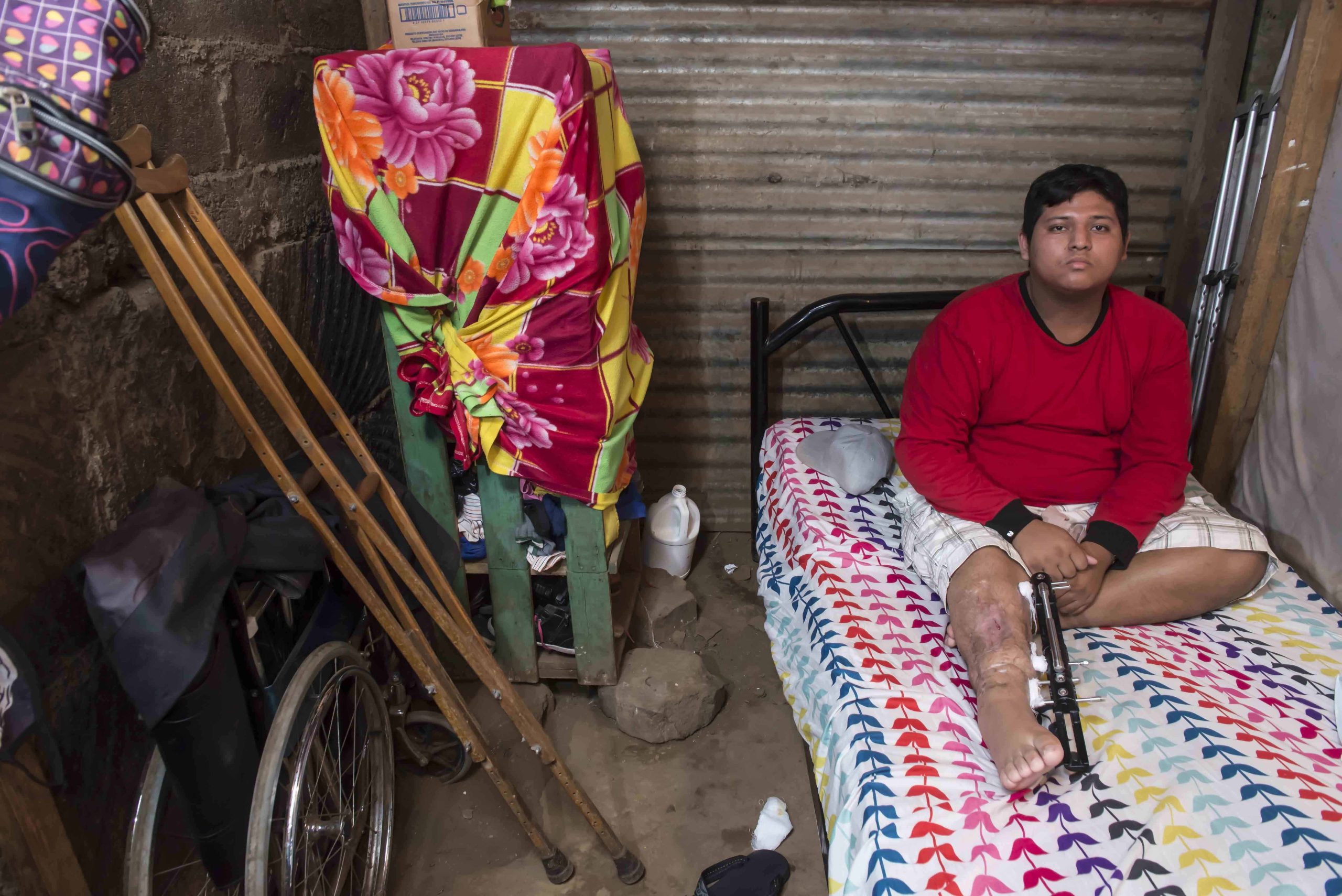
The tragic trail of people crippled by the government in Nicaragua continues in a small brick-walled room, where a 72-year-old man lies in bed —almost dead. He is another victim of State violence against citizens, despite the fact that he wasn’t protesting,
His name is Justo Rodriguez. Up to April 20th, he was a farmer in the community of Esquipulas, in Moyogalpa, island of Ometepe. But nowadays, his arms tremble occasionally and he can’t move on his own. He is in a vegetative state, he’s malnourished and he merely babbles when he wants to tell his sister Esmerita, 70, that he is in pain.
At 7 am on April 20th, Justo was walking to work when the Police stopped him without any explanations as to why. They were conducting a raid in the area because a group of people had protested against the government the night before, but Justo had not been a part of that group. “He was never into politics,” his sister asserts.
Yet he was put inside a police car with other detainees. Five days later, Esmerita was able to visit him in jail and he told her that the police officers had dropped a tire on his chest and they had repeatedly kicked him.
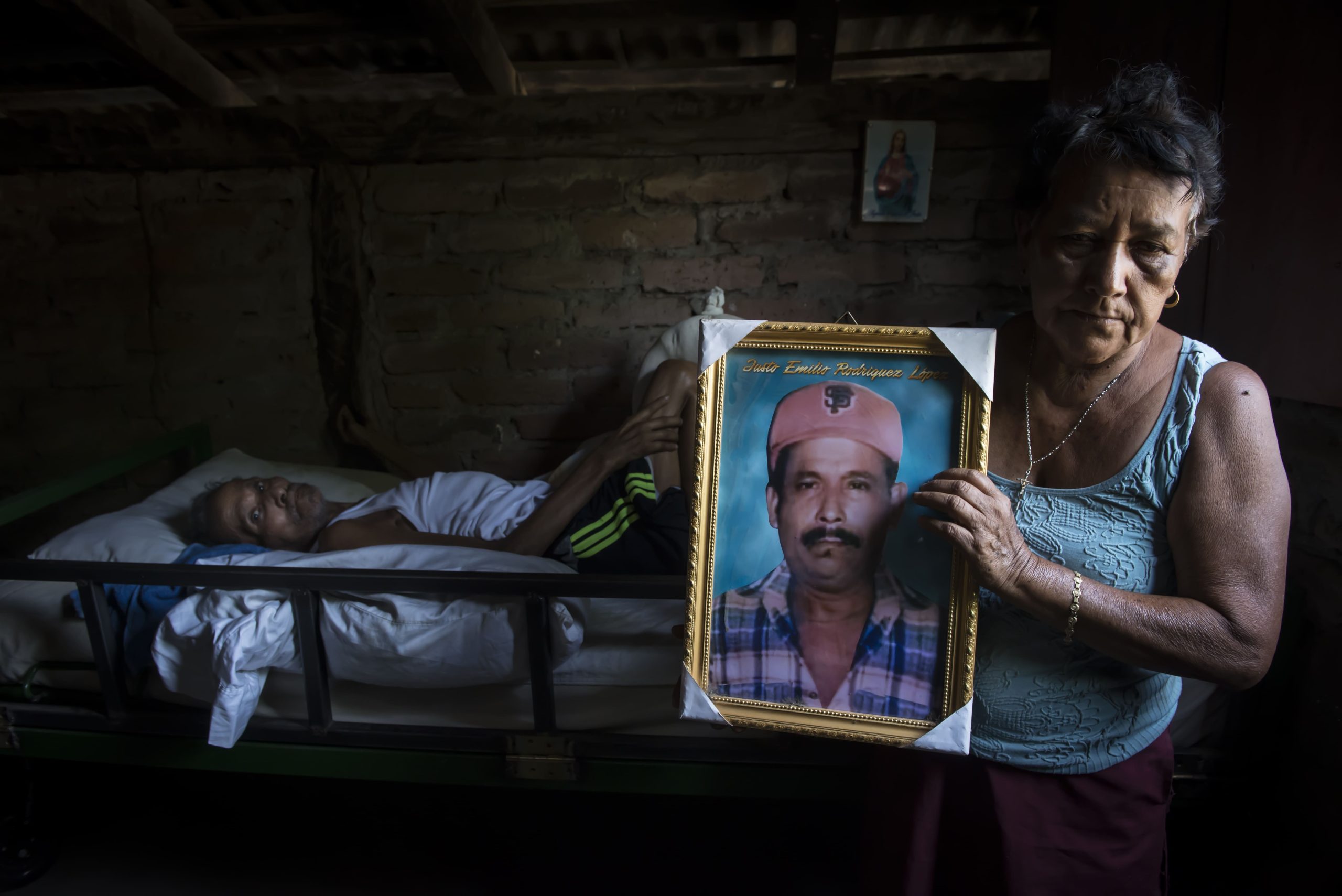
It took six months for Esmerita to see him again, and he was not the same. A truck of the Jorge Navarro Penitentiary System, better known as “La Modelo”, went to her home and picked her up to take her to the Lenin Fonseca hospital, where they had taken him.
In the hospital, Esmerita found her brother unconscious and intubated. He had been there for two months and no one had told her. A doctor explained that Justo had had a stroke, that beating to the head had caused clots of blood in the brain, and that he had emergency surgery.
“The doctor said: `15 more minutes and he would have died. He is in observation for 72 hours, but you have to be here because we will take out the tube if he doesn’t respond´. He did wake up, but he will never be the same. He used to be chubby and now he is malnourished. We talk to him and he just stares back at us,” she laments.
Justo was hospitalized for four months. On December 21st, 2020 he was released and taken to her sister’s home to recover. When she changed his clothes, she saw a wound with fifty stitches in his lower back. She still has no idea what happened or what they did to him.
Nobody has been able to explain to Esmerita how her brother, a vigorous, joyful and industrious man, ended up in the state he is today. Not even the warden, Edwin Blandon, was able to clarify what had happened. Instead of an explanation, the warden offered her money. “Just show me where he is,” that was all she demanded.
After a medical checkup, Esmerita was told Justo has chronic anemia and a lesion on the heart. “He can’t speak, he can’t feel and his memory is failing. When we give him something, he says we didn’t give him anything. People come over to visit him and he can’t remember who they are. His mind is not okay,” his sister says.
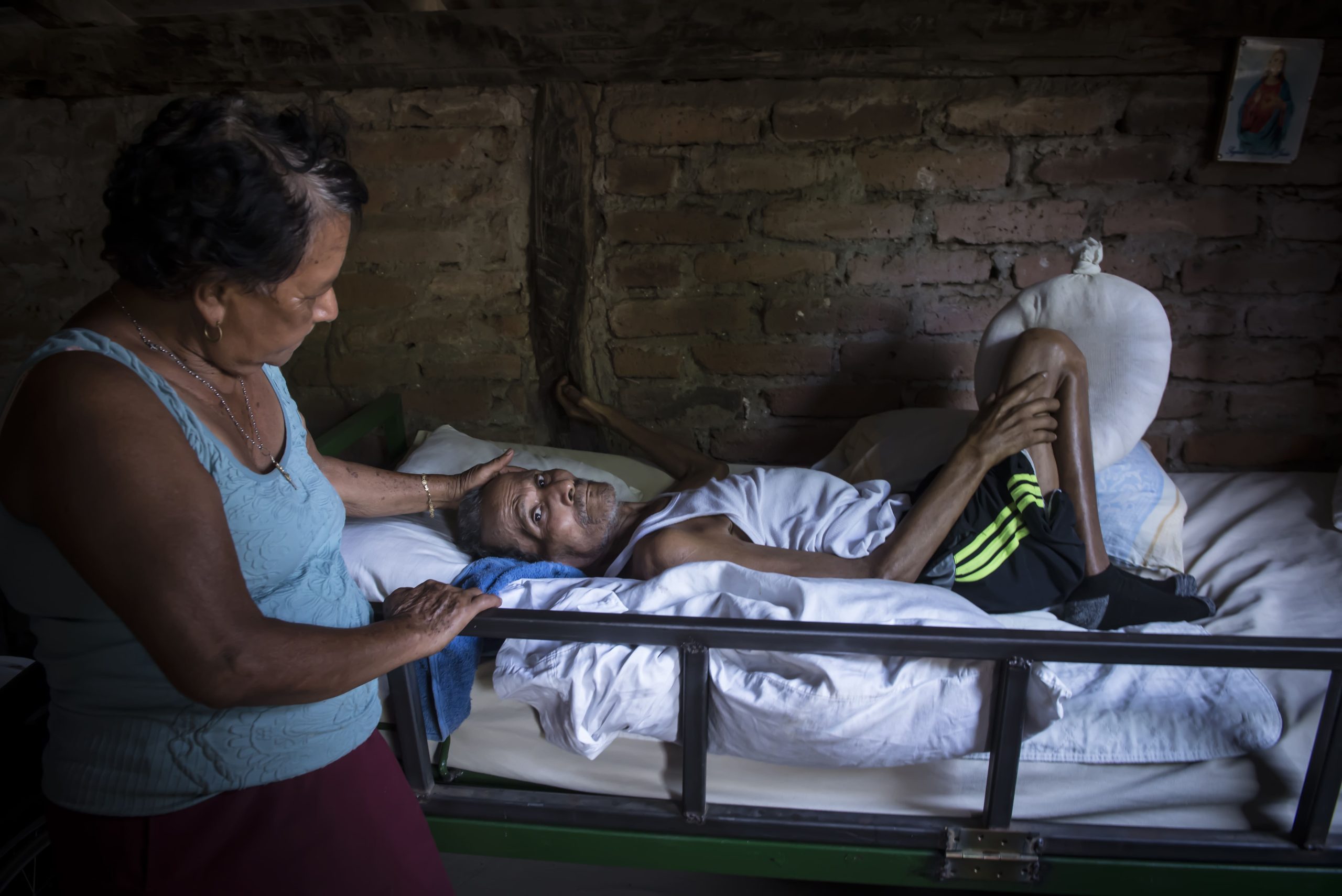
More than 2,000 People Injured by the Repression
The cases of Holver Zelaya, Isaac Ramirez and Justo Rodriguez are only three, but there are over 2,000 injured people as a result of the State repression in Nicaragua, according to the most recent report of the IACHR, dated August 29th, 2022.
The IACHR does not give an exact figure of injured people and it doesn’t specify if all of them were disabled or have some type of motor injury. To date, there is no precise record of the amount of people crippled by repression in the country.
The human rights collective Nicaragua Nunca Mas claims it has been difficult to calculate the exact number. “There are some people who refrain from filing reports out of fear of retaliation,” the director of the organization, Gonzalo Carrion explains. “The IACHR says that there are more than 2,000 injured people, but out of those, he wonders, how many sustained irreversible damage?”
The State has not disclosed the number of people crippled by its repression since 2018, it only acknowledges 199 casualties; according to the pro-government discourse, 23 of them were police officers and the rest were supporters of the Sandinista National Liberation Front, the ruling party. The government has held the opposition’s protestors accountable for these deaths, accusing them of being “coupists” and “terrorists”.
A database compiled for this investigation verified 147 cases of people who were left crippled for life as a result of the State repression. Out of them, 127 are known members of the opposition and 20 have no political preference. None of the people we consulted considers him or herself to be Sandinista.
These revelations are based on testimonies of some of the victims, on a review of journalistic files and on conversations with families, friends or the people who have been left disabled. Most of them requested us not to share details of their cases out of fear of retaliation from the State. Consequently, the database is not being published.
There are 147 disabled people, all male, ranging from the age of 18 to 72. By majority, men resisted the State’s oppressive forces from the blockades. They defended themselves with mortars, rocks, marbles and hand-made bombs, while the police and the paramilitaries used weapons of war such as: AK-47, SVD rifles, PK machine guns, M16 rifles, Remington Model 700, Jericho 941 semi-automatic pistols and Soviet drum magazines that hold up to 75 bullets, as per the findings of criminologist Giancarlo Fiorella, published by the Netherlands-based collective of researchers Bellingcat.
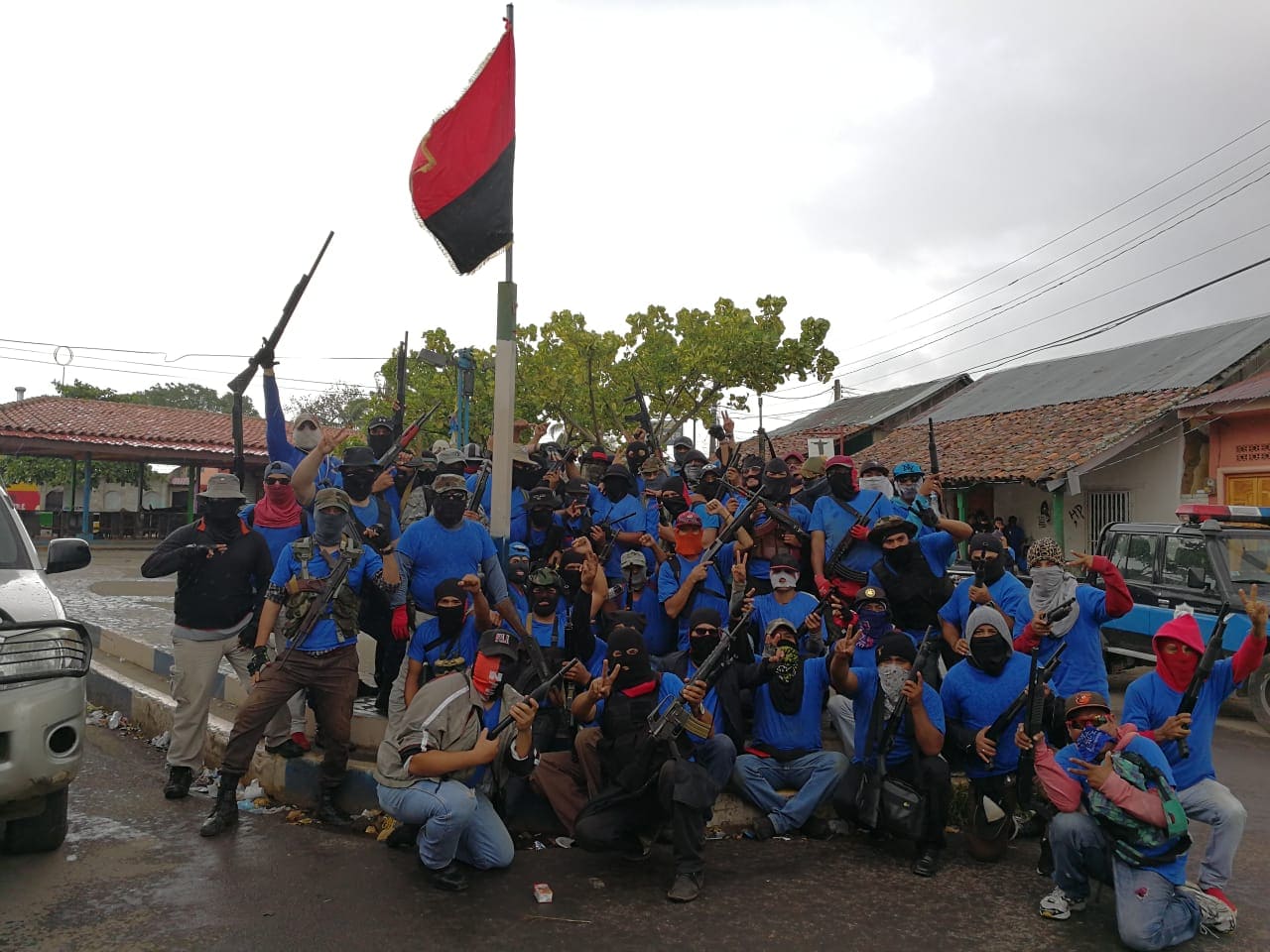
Additionally, 67 were shot in one arm, 17 in one leg, two in the head, three in the back and two in the abdomen. Out of the total, at least 23 have reduced mobility in an arm or leg, and 18 had to have an amputated limb.
Moreover, they were mainly young: 54 were students and 48 were farmers. The group includes craftspeople, bakers, athletes, journalists and drivers, among other professions.
The date and place of the attacks reported by the disabled people were recorded as well, and then contrasted with the dates and places in which clashes between protesters and the repressive forces of the State took place. The 147 disabled people state that their injuries happened after April 18th, 2018, the date in which the protests in Nicaragua started.
Some of them showed photographs, videos and even epicrisis, x-rays and bullets that were removed in private hospitals, as evidence.
A report entitled Shoot to kill, published in 2018 by Amnesty International, states that most shots fired by the Police and paramilitary groups were “aimed at the head or chest, and caused irreparable effects” to the opposing protesters. This would explain why most of the disabled people verified by CONNECTAS and Galeria News were shot above the waist.
Crippled and Threatened by the State
Doctor Alejandro Lagos treated many injured people in his private office. Even though he does not have an official number, he estimates that he has helped over 100 victims, and even today, he still follows-up on some of them.
The cases he has worked on involve paraplegia, loss of an eye, amputated limbs, punctured vital organs and even victims in vegetative state. The doctor fears that these people have been practically abandoned by the State.
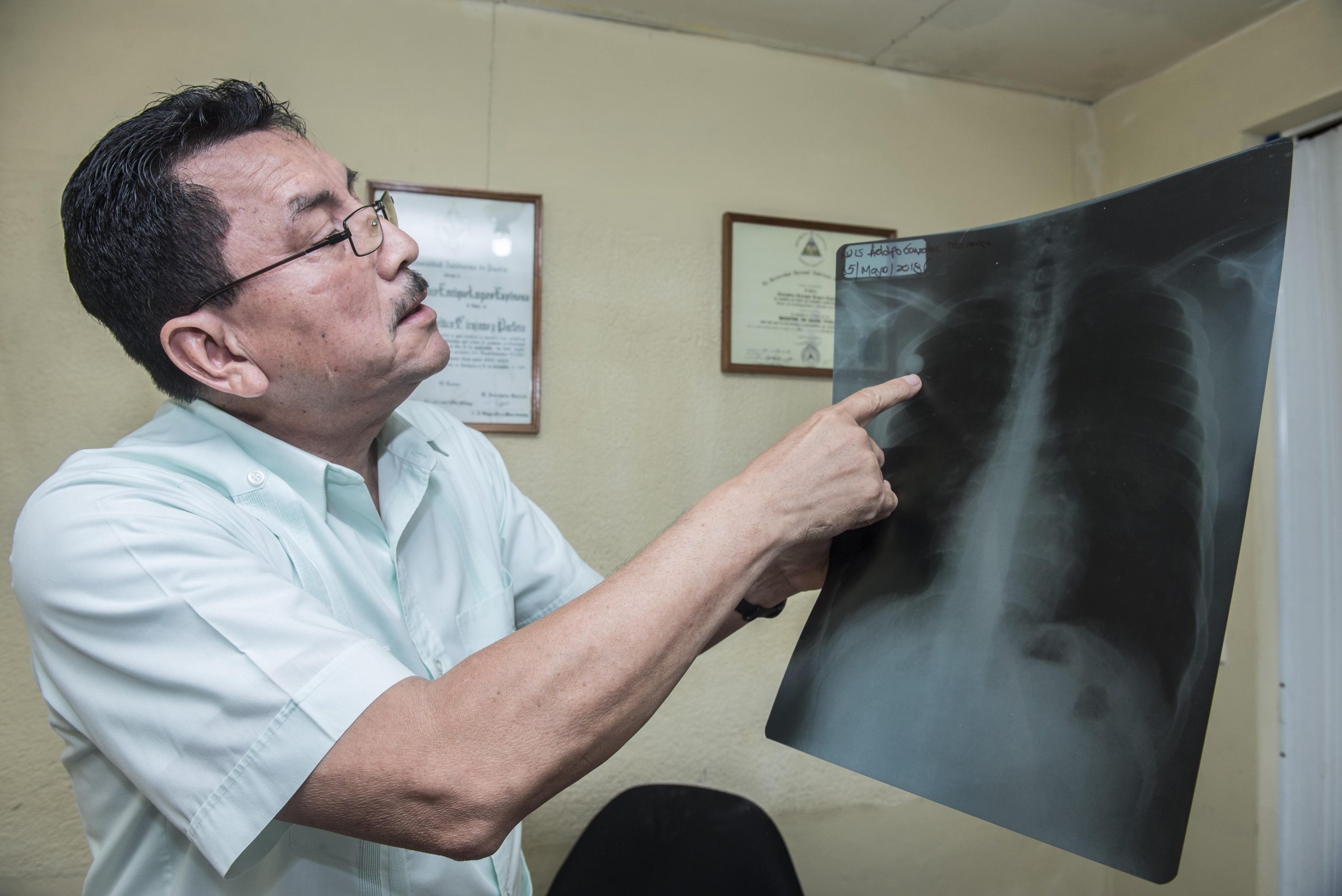
When the protests against President Daniel Ortega broke out, doctors in public hospitals denounced that the Minister of Health at the time, Sonia Castro, had given the order not to care for injured people taken to hospitals as a result of State oppression. “Several public hospitals such as hospital Cruz Azul, hospital Aleman and hospital Lenin Fonseca allegedly refused to treat injured protesters,” Amnesty International says in its 2018 report.
“The order was given by the Minister of Health,” confirmed doctor Jose Luis Borgen in a press conference held on February 18th, 2019. He was fired from the hospital Lenin Fonseca for going against Castro’s order and treating people wounded by the repression. According to the IACHR, 400 health practitioners have been fired from public hospitals in Nicaragua to date.
The IACHR also identified “numerous cases” in which injured people stopped visiting State health centers “due to distrust or fear of retaliation, being left without medical attention, or opted for private hospitals, improvised health centers or volunteer doctors, firemen and medicine students, among others.”
In fact, out of the 147 disabled people confirmed by CONNECTAS and Galeria News, only 21 went to a public hospital. 111 sought private medical attention and 15 claimed they never got any medical attention until this date.
The reason why 126 of them refused to visit a public hospital was fear of incarceration and of denial of medical attention, some, such as Holver Zelaya, declared they were afraid of being murdered.
Carlos, one of the victims who didn’t go to a hospital, is a 32-year-old who was shot in the left leg. He shared his story with us under the condition of protecting his identity. “Where I live, some of my neighbors are `rats´ (pro-government supporters). I am surrounded by them, so it’s better to be safe than sorry,” he explains.
Carlos is from the indigenous neighborhood of Monimbo, in Masaya, 27 kilometers away from the capital. He joined the demonstrations against the government and helped in the blockades set up by the people of the area.
In the early hours of June 14th, 2018, he was in one of the blockades with other three people when the bells of the neighborhood’s church began ringing. It was the signal that the paramilitaries had arrived in town to carry out the Operacion Limpieza.
Carlos recalls that he was passing some mortars to another young man to fire back at the paramilitaries. At one point, they ran because the enemy was very close. He didn’t have time to do it, so he threw himself to a riverbed near the blockade to hide.
The paramilitaries had captured someone and taken him to Carlos’s blockade. “The victim had been shot in the abdomen and they said to each other: `go ahead, kill him.´ The man was screaming for help, I was in the riverbed, hiding. If I stayed there, I was going to get killed too,” he says.
He couldn’t help the man and he doesn’t know what happened to him. “Perhaps they killed him, they were ready to finish him off.” Carlos knew they would find him so he started running for 500 meters, as fast as he could, to try to reach the street where his friends were.
But they spotted him and started shooting at him. Carlos ran in zigzag to dodge the bullets. When he had almost reached safety, a bullet pierced through his left calf.
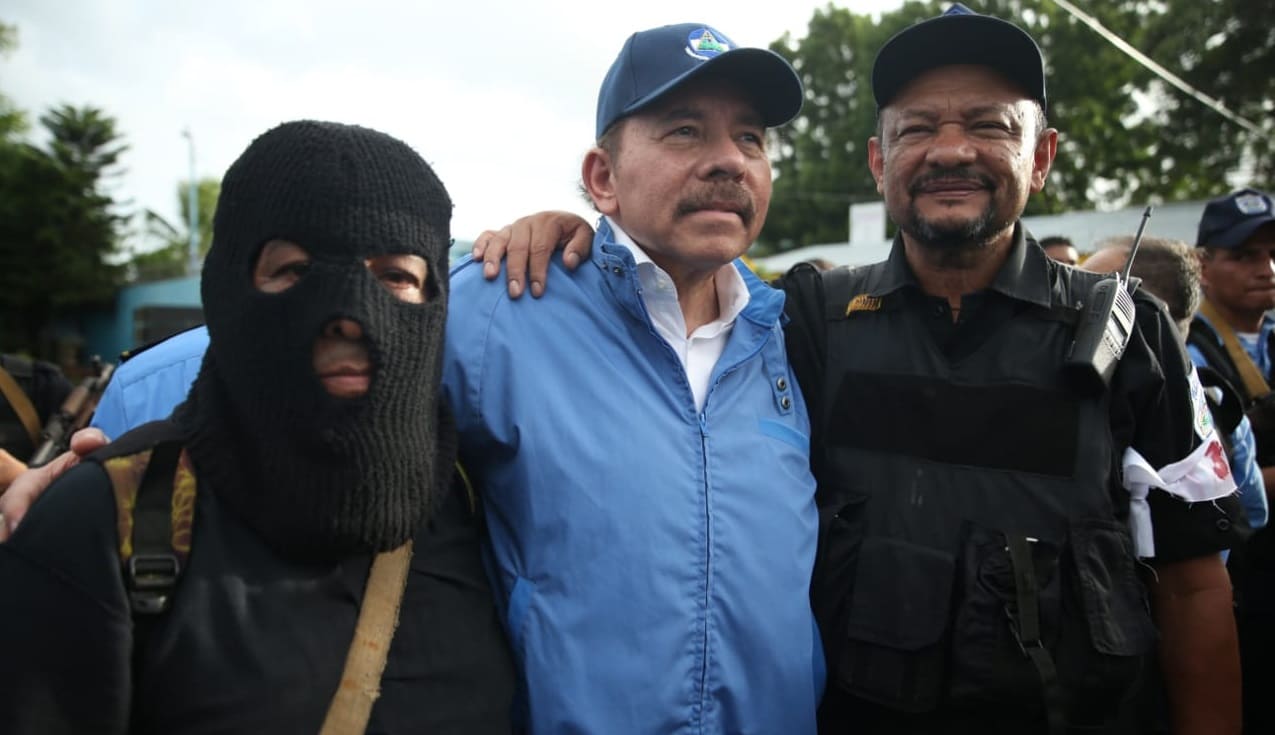
His friends took him to an improvised medical care center run by medical students and some professional doctors and nurses treating injured victims. One of them told them he needed to be taken to a hospital because he would bleed to death and that the bullet had to be removed, but he refused.
He had heard that the Police were in the roads stopping cars and buses, searching for members of the opposition. Also, he was afraid that the hospital would treat him and then report him for arrest. He chose to be treated by a relative with medical knowledge at his home.
That person explained to him that the bullet had gone through the knee, so the wound was sutured to stop the bleeding. Ever since, Carlos can’t walk properly. He used crutches for a while. Now he walks without crutches but he has a limp.
It is painful at night, especially when it’s cold. The knee gets swollen sometimes, but he can’t call in sick to work because he is the sole provider of his family, he has a 7-year-old girl.
He has never been to a hospital to get treatment or physical therapy. He fears being incarcerated. “This is really ugly. If you say something they don’t like, they put you in jail,” he comments.
Lawyer Gonzalo Carrion says that, to make things worse, these people have been threatened by paramilitaries or pro-government supporters. They have had to leave their homes and towns to escape harassment and threats.
That is the case of Isaac Ramirez. The young man claims that he has been harassed by pro-government supporters, in particular by some of his neighbors who are watching if he leaves his house or if someone pays him a visit.
Holver Zelaya says he has experienced the same thing. Days after he was shot in 2018, the paramilitaries came looking for him at his home. “They were there to kill me,” he said. For his safety and his family’s, he had to move to a different part of the country which he prefers to keep secret.
Carlos still lives in Monimbo, but in 2018 he had to leave town for a while. Three days after his attack, the paramilitaries broke into the city. He didn’t feel safe where he was, so he was taken to a relative’s house. He was spotted by a pro-government supporter when he got there.
“I couldn’t stay long, I had been seen and I knew I was going to be reported. I left at 8 am and they got there at 10. They aimed at my cousins with guns, searched the house and asked about me,” Carlos adds. Some time went by and he had to go back to Monimbo because he couldn’t leave his family unprotected, now he is afraid of his neighbors, all of which are pro-government supporters.
In the case of Justo Rodriguez, his sister says that the Sandinistas are watching who visits him. “What else could they do to him? He can’t even talk. They can’t say he’s been protesting,” Esmerita indicates.
Some victims of State repression still have bullets lodged in their bodies, for instance Enoc Lopez, who has a bullet behind his right eye and another one in the back of his brain. He was protesting with a group of young people on April 20th, 2018, when the Police arrived to break up the manifestation. The man heard shots and ran for shelter, then he felt something hit his forehead.
He lay stretched out on the floor, conscious. He had no idea he had been shot. They took him to the public hospital Lenin Fonseca, where he went into surgery to have the bullets removed. The hospital claimed they had removed one of the bullets, but an x-ray he took in 2021 in a private clinic revealed that they had lied to him —there are still two bullets lodged in his head.
He has a scar from temple to temple, and he has a dent in his forehead because the bullets broke his skull. Enoc tells us that people make fun of his facial appearance, so he lets his hair grow long to cover it up a little.
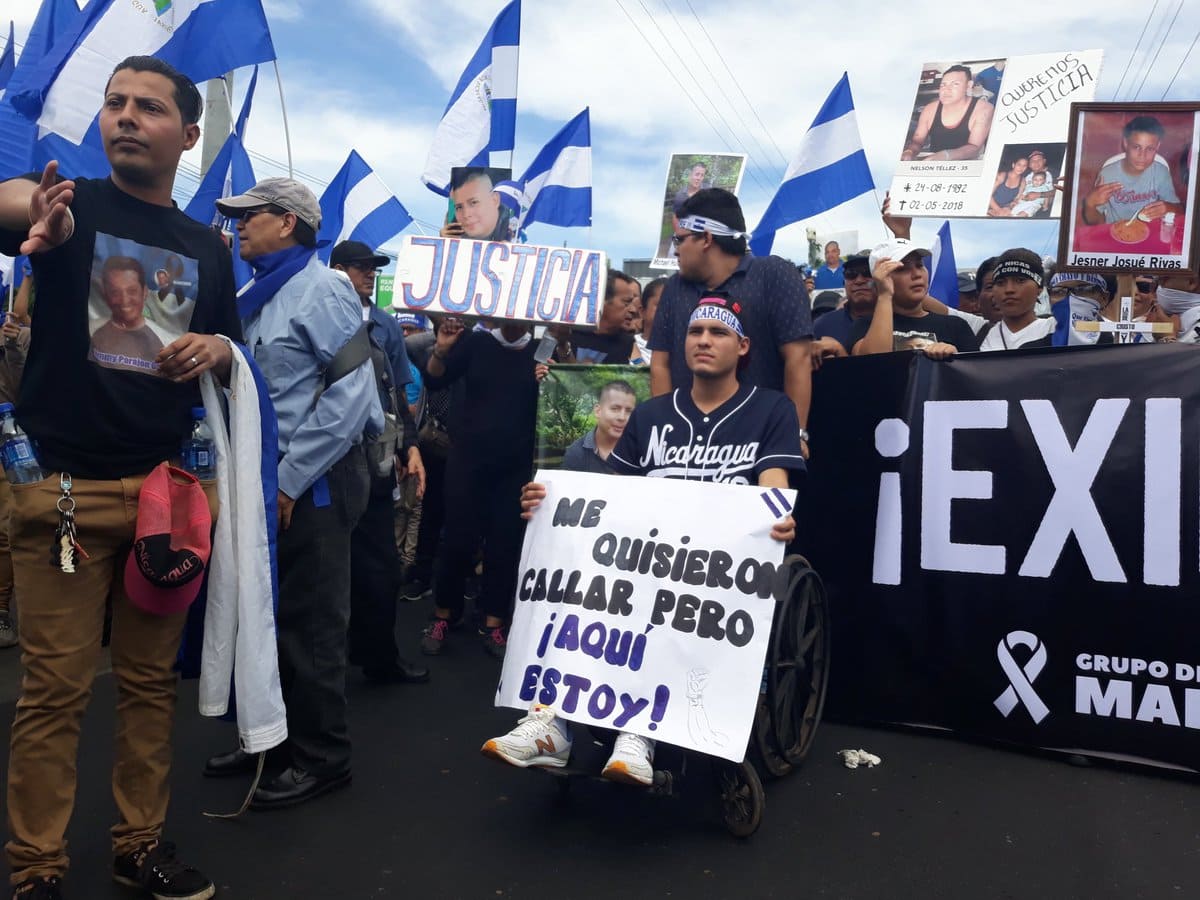
History Repeating Itself
What began in Nicaragua in 2018 with the injured victims caused by political motives reminds us of the country’s civil war in the 80s. From 1979 to 1990, the Sandinistas faced an army that was armed and funded by the United States, in what has been known as the “Contrarrevolucion”. The purpose of that irregular army was to topple the Sandinistas, but they failed to accomplish it.
The war ended in 1990 and the official estimate of casualties is approximately 50,000. But, similarly to the people crippled by repression in 2018, there is no official record of Nicaraguans who were left with some type of injury following that fratricidal confrontation.
By the mid 90s, the number of people crippled by the war was estimated to be 11,500, according to journalistic reports that cite figures of the INSS, which had to provide them with a war pension.
The most current figures published in the INSS statistical annual report regarding those pensions are from 2020. The document states that, up to that year, the institution had granted a total of 29,611 pensions, which that year had amounted to 1,004,748,154.43 cordobas (a little over 27 million dollars) of taxpayers’ money.
Nevertheless, the new generation of disabled victims have no pension or compensation by the authorities. Lawyer Gonzalo Carrion explains that these people are entitled to compensation by the State and he highlights a significant difference between both generations. “The disabled people of the 80s are the result of a war between two parties, but those of 2018 were crippled by an armed repression against unarmed civilians,” he asserts.
Not all of the people crippled by the war get a pension, that is why the number of pensions granted by the INSS isn’t accurate enough to determine how many victims were left by the war in the 80s.
Manuel was a Sandinista fighter back then. Nowadays, he opposes Daniel Ortega and he asked us to protect his identity to avoid retaliation. This man lost one of his legs after a bazooka exploded less than two meters away from where he was. “The explosion threw me away and my leg was shattered. I thought I was going to die right there,” he recalls 36 years after the incident.
Manuel’s leg was amputated in August 1986, days after the incident of the explosion. At the time, aged 19, he was fulfilling the enforced military conscription. Today, aged 55, he says he has never received a pension or assistance from the State. He admits that he was never interested in doing what he needed to do to obtain financial aid. “You get very little. Those pensions don’t even cover medications”, he criticizes.
In the 90s, when these pensions were created, the recipients were assigned between 100 and 380 cordobas (14 to 54 dollars of the time), depending on the injury. The pensions have been readjusted; in 2019, the INSS reported the latest increase in a press release that points out that the victims of the war are entitled to a pension capped at 2,481 cordobas (67 dollars).
“The pension is shit. It is worthless.” The old veteran insists, but he concurs with the feeling of Holver Zelaya and the rest of the “new” generation that has been crippled by repression: they feel neglected.
After his amputation, Manuel was granted a military discharge. He opened a transportation business with a brother-in-law, based in the capital. It has helped him make a living to this day. “Business is not bad at all”, he adds. He has learned how to live without his leg.
In the meantime, Holver Zelaya is learning how to live without being able to walk again. In the first months of his recovery, the farmer couldn’t defecate so a doctor recommended him to get a colostomy in a private clinic in early 2021, now he needs a pouch to collect his stool.
Holver still has another ten shotgun pellets in his arm, right hand and in his back, but he hasn’t been able to get them removed and they cause him intense pain. He doesn’t have money to pay for private medical treatments and he has stayed away from public hospitals to avoid being sent to jail. “Or even worse, I could end up dead,” he argues.
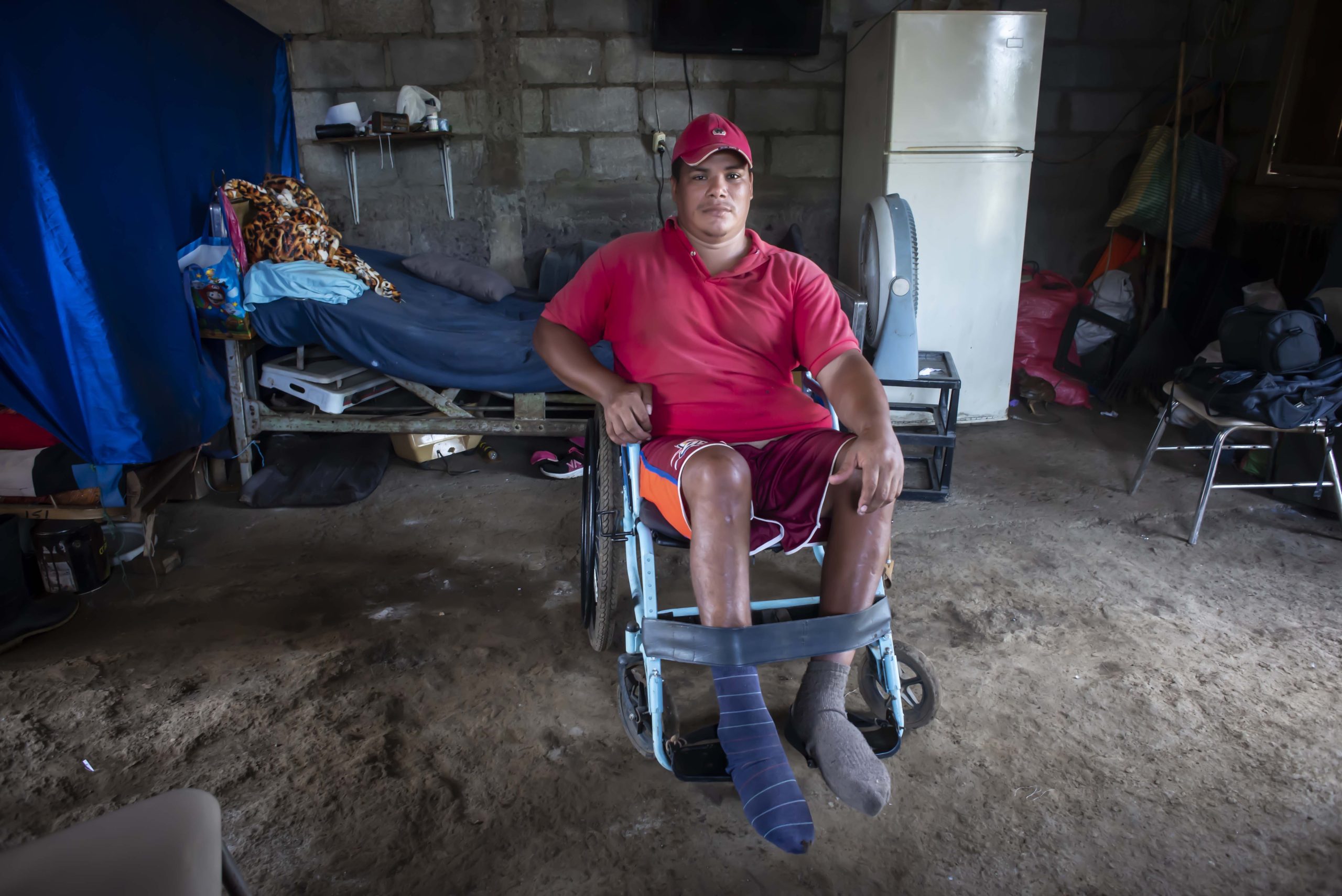
Due to his disability, he can’t work and he can’t put food on the table. Every morning when he wakes up, Holver gets on his wheelchair and goes to the yard to play with the chickens and the rooster, but the thought of feeding his daughters (7 and 9) never leaves his mind. “Sometimes we give bread and water to the girls,” he explains. Sometimes they eat eggs. But they always go to bed without eating dinner.
Furthermore, Zelaya needs to pay his medical expenses. Each colostomy bag costs 125 cordobas (3.42 dollars) and he doesn’t have enough to buy even one. When he sat with CONNECTAS and Galeria News, he had used the same bag for two weeks and it was clearly dirty and damaged.
If Holver had a disability pension he could cover some of his medical needs and his family’s food, but he deems it unlikely. “The government doesn’t help people in my condition (crippled), and If I ask for help I might be put in jail”.
His wife, Elba Maria Ortiz, mentions that Holver used to be cheerful and that he was always smiling; he loved horseback riding, bull riding and playing baseball on the weekends. “Now he is depressed, but we are moving forward with God’s fortitude,” she remarks.
Esmerita Rodriguez says that her brother Justo is sad. Sadness is all she sees in his muted face and his fixed stare. She says it’s painful and for her to see him in this condition, she feels helpless. “He is unwell. His calves are unresponsive, they are hard and shrunk. The doctor said he won’t walk again. He is apathetic and he doesn’t always eat,” she explains.
Enoc Lopez and Isaac Ramirez claim they are depressed. Isaac’s dreams have been cut short, he had to quit school and stop practicing martial arts after he lost his leg. He is learning how to cope with living without a leg. “It is hard,” he repeats while he looks at his stump.
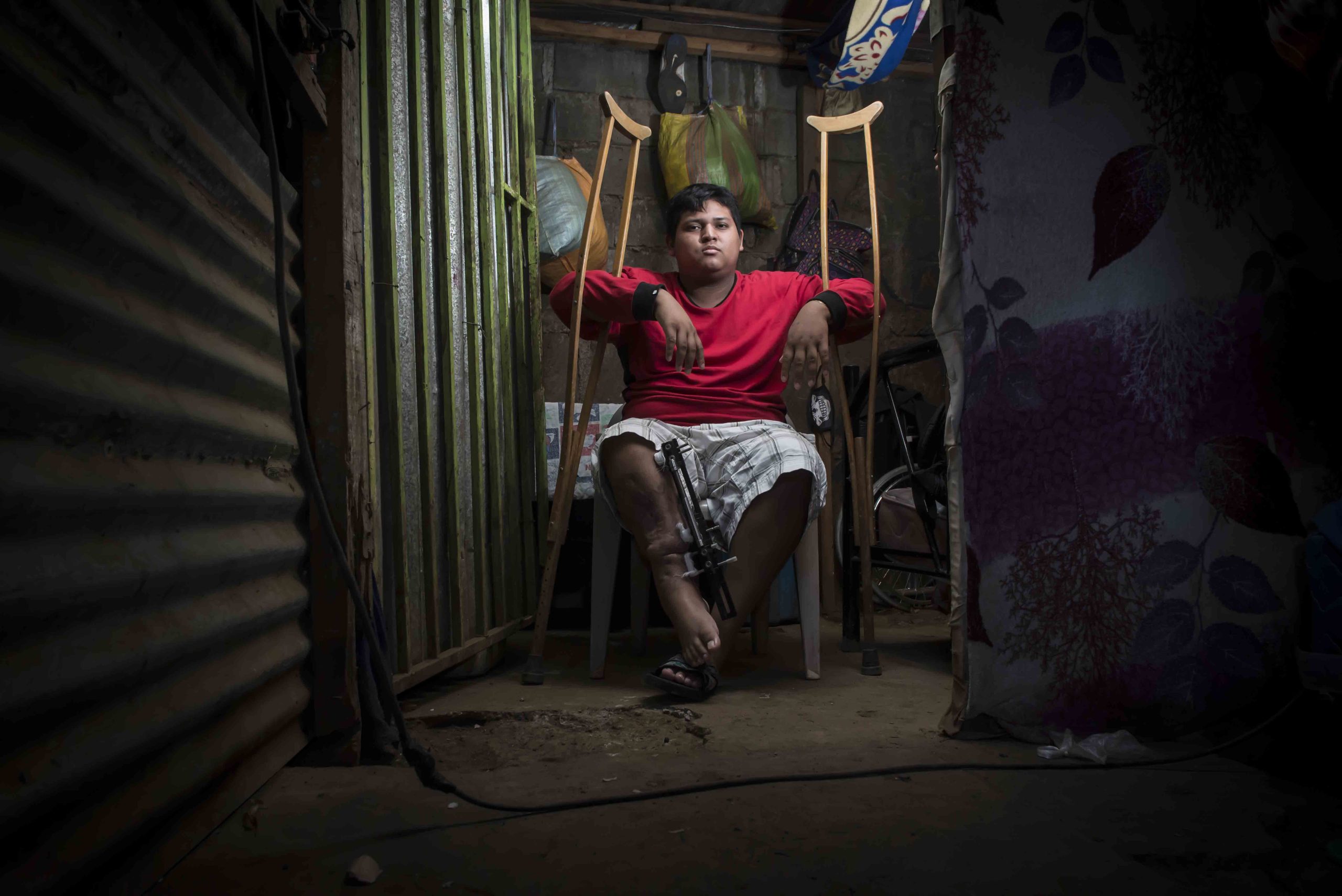
Isaac uses some old crutches to move around, sometimes he uses a wheelchair. Baseball and martial arts are not in his life anymore. He is trying to train as a barber to make ends meet.
For his part, Enoc, who had lost mobility of the right side of his body after being shot in the forehead twice, slowly recovered it after months of physical therapy and treatment by private specialists.
Four years have passed and he is able to walk again with special shoes. But the headaches persist; additionally, he has been told he will lose sight due to the bullet that is lodged in the back of his right eye.
“It has been a difficult process. Especially learning to walk again”, Enoc says. He is ambidextrous now, he had to learn to write and to eat with his left hand after not being able to use his right hand.
Ver esta publicación en Instagram

